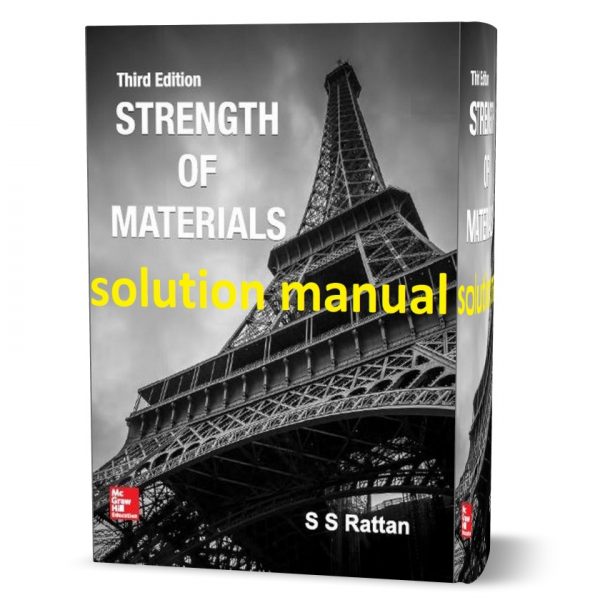Strength of materials by SS Rattan 3rd edition solutions manual pdf
Original price was: $52.00.$42.00Current price is: $42.00.
Published: 2017
Edition: 3rd
Pages: 139
Type: pdf
Size: 1 MB
Content: includes all chapters of the textbook ( 1 to 18) answers
Sample: solution sample file
Download After Payment
- Description
- Reviews (0)
Description
Description
download free Solution Manual Strength of Materials 3rd Edition by S S Rattan 3rd edition McGraw-Hill pdf An engineer always endeavors to design structural or machine members that are safe, durable and economical. To accomplish this, he has to evaluate the load-carrying capacity of the members so that they are able to withstand the various forces acting upon them. The subject Strength of Materials deals with the strength, stability and rigidity of various structural or machine members such as beams, columns, shafts, springs, cylinders, etc. These days, a number of books on this subject are available in the market. It is observed that most of the books have a few good features in them, their overall ranking drops when considered on composite parameters like coverage of a topic, lucidity of writing, variety of solved and unsolved problems, quality of diagrams, etc. For more solution manuals click here
Solution Manual Strength of Materials 3rd Edition by S S Rattan McGraw-Hill pdf
Usually, the students have to supplement one book with a few others to comprehend the subject. The present book aims to provide all known good features in single book. The book aims to be useful to degree-level students of mechanical and civil engineering as well as those preparing for AMIE and various other competitive examinations. However, diploma-level students will also find the book to be of immense use. The book will stand to benefit postgraduate students to some extent as it contains some advanced topics like bending of curved bars, rotating discs and cylinders, plastic bending, circular plates, etc.
The salient features of the book are as follows: • Moderately concise and compact text covering all major topics. • Simple language aimed to benefit average and weak students. • Logical and evolutionary approach in descriptions for better imagination and visualization. • Physical concepts from simple and readily comprehensible principles. • Well-defined learning objectives based on Bloom’s Taxonomy for each chapter. • Summary at the end of each chapter. • LO and LOD tagging of the chapter content. • Difficulty level indicator for each example, problem and objective type question. • An appendix containing important relations and results. • Rich pedagogy includes o Illustrations: 542 o Solved examples: 450 o Objective type questions: 220 o Review questions: 175 o Problems: 210
Chapter content of this economic eBooks
External forces acting on individual structural or machine members of an engineering design are common. An engineer always endeavors to have such designs that are safe, durable and economical. Thus, the load-caning capacity of the members being designed is of paramount importance to know their dimensions to minimize the cost. The subject Strength of Materials deals with the strength or the load-carrying capacity of various members such as beams and columns. It also considers their stability and rigidity. Theory of Structures involves the application of these principles to structures made up of beams, columns, slabs, and arches.
Solution Manual 3rd Edition by S S Rattan McGraw-Hill
The download free Solution Manual Strength of Materials 3rd Edition by S S Rattan 3rd edition McGraw-Hill pdf force acting on a body is termed as load. A concentrated load is also known as a point load, and a distributed load over a length is known as a distributed load. A distributed load of constant value is called a uniformly distributed load.
This download free Solution Manual Strength of Materials 3rd Edition by S S Rattan 3rd edition McGraw-Hill pdf type of pull may also be applied if one end of the body is fixed (Fig. 1.1b). In this case, the balancing force is provided by the reaction of the fixed end. Such type of a pulling force is known as tension or tensile force. A tensile force tends to increase the length and decrease the cross-section of the body. In a similar way, a force tending to push or compress a body is known as compression or compressive force which tends to shorten the length (Fig. 1.1 c). Usually, the forces acting on a body along the longitudinal axis are known as direct or axial forces, and the forces acting normal to the longitudinal axis of a body are known as transverse or normal forces.
In the elementary theory of analysis, a material subjected to external forces is assumed to be perfectly elastic, i.e., the deformations caused to the body totally disappear as soon as the load or forces are removed.



Reviews
There are no reviews yet.